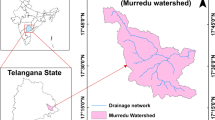Abstract
Morphometric analysis is an indispensable tool for hydrological investigation that involves the development and management of drainage basin. This study characterizes the micro watersheds in the Palar sub-watershed using morphometric analysis and assesses its risk by land use and land cover features in a particular micro watershed. Palar sub-watershed is divided into 6 micro watersheds for prioritization based on morphometric and land use analysis. Several morphometric parameters (linear, shape and relief) are determined from the drainage map; ranks are assigned based on their capacity to induce erodability and degradation. Final ranking is based on the composite index calculated from the sum of the ranks of each morphometric parameter. Morphometric analysis reveals micro watersheds 5 and 6 as most susceptible and 2 and 3 as low susceptible. Land use is mapped using IRS ID LISS III satellite data. The risk in terms of watershed degradation involved to each micro watershed is based on the ranks of each land use feature, obtained from a similar composite index as that of morphometric analysis. Land use analysis shows that micro watersheds 2 and 4 fall under high priority category while 5 and 6 under low priority category. Integration of the morphometric and land use analysis shows that only micro watershed 1 falls under the same category in both analyses. Control measures are suggested to contain degradation depending on its specific land use pattern and morphometric features. This study can be used to prepare a comprehensive watershed plan for the development or for planning resource conservation strategies, by integrating land use features with the drainage characteristics of the region, in particular for a hill ecosystem as the prioritization is at micro level.
Similar content being viewed by others
Reference
Avery TE (1975) Natural Resource Measurements. McGraw-Hill Book Company, New York, USA. pp 339.
Biswas S, Sudhakar S, Desai VR (1999) Prioritisation of subwatersheds based on morphometric analysis of drainage basin: A remote sensing and GIS approach. Journal of Indian Society of Remote Sensing 27(3): 155–166. DOI: 10.1007/BF02991569
Horton RE (1945) Erosional development of streams and their drainage density: hydrophysical approach to quantitative geomorphology. Geological Society of America Bulletin 56: 275–370. DOI: 10.1130/0016-7606(1945)56[275:EDOSAT]2.0.CO;2
Gregory KJ, Walling DE (1973) Drainage basin form and process: a geomorphological approach. Wiley, New York, USA. p 456.
Javed A, Khanday MY, Rais S (2009) Prioritization of subwatersheds based on morphometric and land use analysis in Guna district (M.P.): A remote sensing and GIS based approach. Journal of Indian Society of Remote Sensing 37(2):261–274. DOI: 10.1007/s12524-009-0016-8
Javed A, Khanday MY, Rais S (2011) Watershed Prioritization Using Morphometric and Land Use/Land Cover parameters: A Remote Sensing Approach. Journal Geological Society of India 78: 63–75. DOI: 10.1007/s12594-011-0068-6
Kim JB, Suanders P, Finn JT (2005) Rapid assessment of soil erosion in the Rio Lempa Basin, Central America, using the Universal Soil Loss Equation and Geographic Information Systems. Environmental Management 36(6): 872–885. DOI: 10.1007/s00267-002-0065-z
Lim KJ, Myung Sagong M, Engel BA, et al. (2005) GIS — based sediment assessment tool. Catena 64: 61–80. DOI:10.1016/j.catena.2005.06.013
Mekel JFM (1970) The use of aerial photographs in geological mapping. ITC text book of Photo-interpretations. 8: 1–169
Mesa LM (2006) Morphometric analysis of a subtropical Andean basin (Tucumam, Argentina). Environmental Geology 50(8): 1235–1242. DOI: 10.1007/s00254-006-0297-y
Miller VC (1953) A quantitative geomorphic study of drainage basin characteristics in the Clinch Mountain area, Virginia and Tennessee, Department of Geology Columbia University, New York. pp 389–402.
Patton PC, Baker VR (1976) Morphometry and floods in small drainage basins subject to diverse hydrogeomorphic controls. Water Resources Research 12: 941–52.
Prasannakumar V, Vijith H, Geetha N (2011) Terrain evaluation through the assessment of geomorphometric parameters using DEM and GIS: case study of two major sub-watersheds in Attapady, South India. Arabian Journal of Geosciences 6(4): 1141–1151. DOI: 10. 1007/s12517-011-0408-2:1141 -51
Rekha VB, George AV, Rita M (2011) Morphometric Analysis and micro-watershed prioritization of Peruvanthanam subwatershed, the Manimala River Basin, Keral, South India. Environmental Research, Engineering and Management 3(57): 6–14.
Scheidegger AE (1970) Theoretical geomorphology. George Allen and Unwin, London. pp 243–248.
Schumm SA (1956) Evolution of drainage systems and slopes in Badlands at Perth Amboy, New Jersey. Bulletin of Geological Society of America 67:597–646. DOI: 10.1130/0016-7606(1956)67[597:EODSAS]2.0.CO;2
Schumm SA (1963) Sinuosity of alluvial rivers on the Great Plains. Bulletin of Geological Society of America 74: 1089–1100. DOI: 10.1130/0016-7606(1963)74[1089:SOAROT]2.0.CO;2
Smith KG (1950) Standards for grading texture of erosional topography. American Journal of Science 248: 655–668. DOI: 10.2475/ajs.248.9.655
Sreedevi PD, Subrahmanyam K, Shakeel A (2005) The significance of morphometric analysis for obtaining groundwater potential zones in a structurally controlled terrain. Environmental Geology 47(3): 412–420. DOI: 10.1007/s00254-004-1166-1
Strahler AN (1952) Hyposometric (area-altitude) analysis of erosional topography. Geological Society of America Bulletin 63:1117–1141. DOI: 10.1130/0016-7606(1952)63[1117:HAAOET]2.0.CO;2
Strahler AN (1964) Quantitative geomorphology of drainage basins and channel networks. In: Chow VT (ed.), Handbook of Applied Hydrology. McGraw-Hill, New York. pp 439–476.
Thomas J, Joseph S, Thrivikramji KP, et al. (2011). Morphometric analysis of the drainage system and its hydrological implications in the rain shadow regions, Kerala, India. Journal of Geographical Sciences 21(6): 1077–1088.
Verstappen H (1983) The applied geomorphology. International Institute for Aerial Survey and Earth Science (I.T.C.), Enschede, The Netherlands, Amsterdam, Oxford, New York.
Author information
Authors and Affiliations
Corresponding author
Rights and permissions
About this article
Cite this article
Sujatha, E.R., Selvakumar, R. & Rajasimman, B. Watershed prioritization of Palar sub-watershed based on the morphometric and land use analysis. J. Mt. Sci. 11, 906–916 (2014). https://doi.org/10.1007/s11629-012-2628-7
Received:
Accepted:
Published:
Issue Date:
DOI: https://doi.org/10.1007/s11629-012-2628-7




